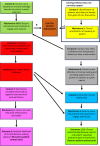Examining how goals of care communication are conducted between doctors and patients with severe acute illness in hospital settings: A realist systematic review
- PMID: 38498549
- PMCID: PMC10947705
- DOI: 10.1371/journal.pone.0299933
Examining how goals of care communication are conducted between doctors and patients with severe acute illness in hospital settings: A realist systematic review
Abstract
Background: Patient involvement in goals of care decision-making has shown to enhance satisfaction, affective-cognitive outcomes, allocative efficiency, and reduce unwarranted clinical variation. However, the involvement of patients in goals of care planning within hospitals remains limited, particularly where mismatches in shared understanding between doctors and patients are present.
Aim: To identify and critically examine factors influencing goals of care conversations between doctors and patients during acute hospital illness.
Design: Realist systematic review following the RAMESES standards. A protocol has been published in PROSPERO (CRD42021297410). The review utilised realist synthesis methodology, including a scoping literature search to generate initial theories, theory refinement through stakeholder consultation, and a systematic literature search to support program theory.
Data sources: Data were collected from Medline, PubMed, Embase, CINAHL, PsychINFO, Scopus databases (1946 to 14 July 2023), citation tracking, and Google Scholar. Open-Grey was utilized to identify relevant grey literature. Studies were selected based on relevance and rigor to support theory development.
Results: Our analysis included 52 papers, supporting seven context-mechanism-output (CMO) hypotheses. Findings suggest that shared doctor-patient understanding relies on doctors being confident, competent, and personable to foster trusting relationships with patients. Low doctor confidence often leads to avoidance of discussions. Moreover, information provided to patients is often inconsistent, biased, procedure-focused, and lacks personalisation. Acute illness, medical jargon, poor health literacy, and high emotional states further hinder patient understanding.
Conclusions: Goals of care conversations in hospitals are nuanced and often suboptimal. To improve patient experiences and outcome of care interventions should be personalised and tailored to individual needs, emphasizing effective communication and trusting relationships among patients, families, doctors, and healthcare teams. Inclusion of caregivers and acknowledgment at the service level are crucial for achieving desired outcomes. Implications for policy, research, and clinical practice, including further training and skills development for doctors, are discussed.
Copyright: © 2024 Gross, Koffman. This is an open access article distributed under the terms of the Creative Commons Attribution License, which permits unrestricted use, distribution, and reproduction in any medium, provided the original author and source are credited.
Conflict of interest statement
The authors have declared that no competing interests exist.
Figures
Similar articles
-
Beyond the black stump: rapid reviews of health research issues affecting regional, rural and remote Australia.Med J Aust. 2020 Dec;213 Suppl 11:S3-S32.e1. doi: 10.5694/mja2.50881. Med J Aust. 2020. PMID: 33314144
-
Promoting and supporting self-management for adults living in the community with physical chronic illness: A systematic review of the effectiveness and meaningfulness of the patient-practitioner encounter.JBI Libr Syst Rev. 2009;7(13):492-582. doi: 10.11124/01938924-200907130-00001. JBI Libr Syst Rev. 2009. PMID: 27819974
-
The Effectiveness of Integrated Care Pathways for Adults and Children in Health Care Settings: A Systematic Review.JBI Libr Syst Rev. 2009;7(3):80-129. doi: 10.11124/01938924-200907030-00001. JBI Libr Syst Rev. 2009. PMID: 27820426
-
A realist review of advance care planning for people with multiple sclerosis and their families.PLoS One. 2020 Oct 16;15(10):e0240815. doi: 10.1371/journal.pone.0240815. eCollection 2020. PLoS One. 2020. PMID: 33064749 Free PMC article. Review.
-
Team interventions in acute hospital contexts: a systematic search of the literature using realist synthesis.BMC Health Serv Res. 2018 Jul 11;18(1):536. doi: 10.1186/s12913-018-3331-3. BMC Health Serv Res. 2018. PMID: 29996820 Free PMC article. Review.
Cited by
-
Goals of care discussions among critically Ill patients on vasopressor treatment.PLoS One. 2025 May 28;20(5):e0324482. doi: 10.1371/journal.pone.0324482. eCollection 2025. PLoS One. 2025. PMID: 40435334 Free PMC article.
References
-
- Mulley AG. 30 The role of shared decision making in achieving allocative efficiency in health systems. In: Elwyn G, Edwards A, Thompson R, editors. Shared Decision Making in Health Care: Achieving evidence-based patient choice: Oxford University Press; 2016. ISBN: 9780198723448
-
- Brabers AE, van Dijk L, Groenewegen PP, van Peperstraten AM, de Jong JD. Does a strategy to promote shared decision-making reduce medical practice variation in the choice of either single or double embryo transfer after in vitro fertilisation? A secondary analysis of a randomised controlled trial. BMJ Open. 2016;6(5):e010894. doi: 10.1136/bmjopen-2015-010894 - DOI - PMC - PubMed
Publication types
MeSH terms
LinkOut - more resources
Full Text Sources
Medical



